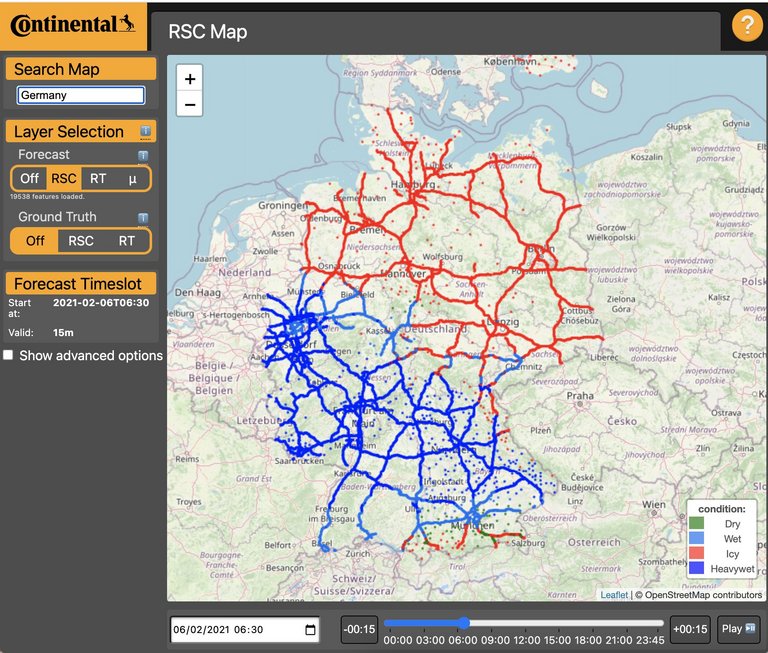Science F(r)iction: Why knowing what’s ahead is so important on highways
Imagine you are traveling along a highway using an assisted or autonomous driving mode. A few kilometers ahead, the weather has changed: the temperature has dropped and rain started to fall. The road might get slippery, traction decreases and there is the potential of hydroplaning. Even worse, on a bridge or in the forest, the water may turn into ice. In these situations, would you feel safe if your vehicle was unaware of the upcoming hazards? And would you trust it to make the right decisions about speed, braking and the distance to other vehicles?
Weather-related fatalities on German roads
- 7 % of all highway accidents with fatalities occurred due to weather-related hazards like snow, ice or heavy rain (German Federal Statistical Office (DESTATIS), 2018)
- In addition, inappropriate speeding under hazardous weather conditions accounted for 23 % of all fatal accidents on rural roads (German Federal Statistical Office (DESTATIS), 2018)
These risks apply to assisted and autonomous vehicles, but also to those under manual control in which even the most skilled drivers face challenges, particularly at night or during periods of low visibility. Therefore, it is critical for both drivers and vehicles, especially when using assisted or automated driving functions (e.g., automatically increasing the distance to the next vehicle when Adaptive Cruise Control is engaged), to know the upcoming road surface conditions in advance.
Solving the data challenge
Today, there are different approaches and data sources used in the market to provide current or upcoming road conditions:
- Some vehicles can reactively measure road friction via onboard sensors and/or software to respond in specific situations, e.g. during braking.
- Global weather forecasts are available but are not always reliable and often cannot predict road conditions in a specific area with high accuracy. Furthermore, there is a clear difference between atmospheric weather and the actual road weather.
- Crowdsourced data can be used to share road surface and friction information, but there is often insufficient coverage and the direct exchange of road condition data between vehicle brands and OEMs is still limited.
The answer to this challenge requires making better use of data. Thankfully, there are already many sources available that can provide a strong base of information, like enhanced (road) weather forecasts, mobile weather sensors, stationary road weather information systems (RWIS), vehicle sensor data, friction data, static and dynamic map data as well as infrastructure maintenance data.
In order to process these data volumes and the complexity of each source, Artificial Intelligence (AI) and especially Machine Learning (ML) are the key technologies for this task as they allow machines to identify patterns and create new rules and algorithms all on their own.
Continental’s Road Surface Condition service
Continental’s Road Surface Condition (RSC) service combines multiple data sources with advanced AI and ML algorithms. The service uses models to predict the surface conditions and predicts the road condition classes as dry, wet, heavy wet, or icy.
The continual service validation helps to improve the ML models. For this, Continental compared its RSC predictions both with data sourced from German RWIS on highways as well as data collected by vehicles and specific hardware of European OEMs in Winter 2020. While already resulting in good accuracy of up to 75 %, the risk of predicting safe road conditions when the surface in reality was icy, only was 1.4 % in both validation campaigns. Moreover, a dedicated validation has been performed for situations in which the air temperature is below 4°C. Below this threshold, new driving features require precise information to be safely activated or deactivated. In this context, the accuracy of Continental’s service is currently at 93%.
The future of Road Surface Condition services
In the future, such services will be improved further by adding new data sources, training more intelligent and complex ML algorithms, and seeking additional use cases that have not yet been covered or even discovered. The enhanced functionality will benefit drivers by alerting them to dangerous situations in advance, improving the utility and reliability of ADAS and chassis functions, enhancing vehicle performance, and building stronger consumer trust and loyalty.

